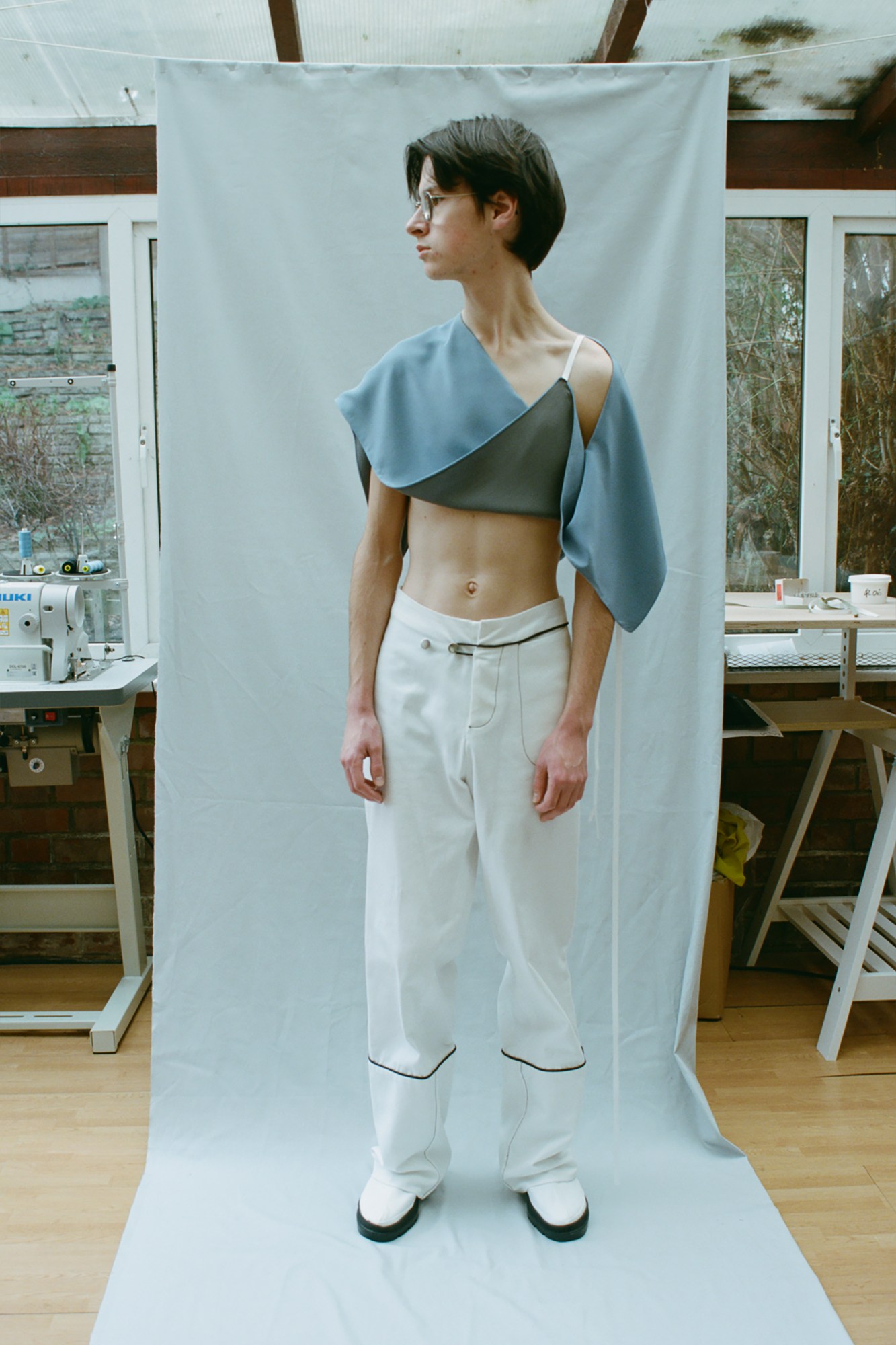René Scheibenbauer’s designs have an intriguing dimension to them. From the “Empathy jacket” — a jacket designed to be worn by more than one person, to the “Abstract-shaped scarf top” — a garment that has no one single way of being put on, the way we see clothing is slowly unlearnt. “When designing I’m drawn to think about the idea of the ‘emotional body’ which is abstract, yet draws a constant link to the physical body,” René says. “This manifests in my designs in the combination of fluid elements and concrete everyday-clothing elements.”
Raised in a small town close to Vienna, René moved to London to study a BA in womenswear at Central Saint Martins. His graduate collection, Empathy, Connection, Play, came runner-up in the 2018 L’Oréal Professionel Designer of the Year Award. Realised through a series of art therapy workshops — in which his friends were invited to interact with different garments and engage with the clothing on an emotional level — René’s approach to design is much more holistic than conventional. “I asked friends that dress very differently from one another to borrow each other’s clothes for my workshop, in which participants could explore themselves blindfolded through touch and interaction with the clothes,” he says. “This playful exploration led each participant to choose the clothes they enjoyed simply from the feel of them.”
Currently available made-to-order through his website (and via one independent shop in Tokyo, Zen Source Clothing) here René presents his latest designs and discusses the method behind his unconventional approach to design.

How do you define your brand?
My brand is still in its early stages. At this point, I’m very cautious not to overproduce while establishing my company’s structure and it’s very important for me to keep awareness of the environmental impact of my work. I’m very committed to sourcing materials from companies that show responsibility on how their practice impacts the environment, and offer environmentally friendly and clean alternatives. Another big element of my brand is its social features… I believe that it is important to rethink the individualistic ways in which we are nurtured. We should move towards a more collaborative state.
Do you consider your skill more technical or more imagination-led?
It is a balance of both at this point. Having a quite technical background, abstract ideas often develop quickly in my mind and I can see how they could be constructed, or what way would be easier to construct them innovatively.

What was the most valuable part of your education?
Studying first at a very technical school gave me a solid grounding in how to construct a garment from point zero. CSM gave me space and guidance to understand creative development, which combined with my foundation, I could learn to develop a more flexible way to execute original ideas. When studying at CSM you come across very different people who cultivate their own identities and their own point of views. It can be rewarding to collaborate with these individuals.
Tell us more about the vision behind your award-winning graduate collection, Empathy, Connection, Play …
I wanted to explore a therapeutic quality within clothing and also bring a social, collaborative aspect to my practice. For my research, I initiated two art-therapy based workshops in order to research how our clothing choices relate to our emotional states. Thinking about the tactile and visceral aspect of clothing.
The garments I created proposed an open and playful form of engagement since there was no ‘correct’ way of them being worn. Throughout the project, I established a collaborative method of design: organising a gathering of participants to interact and play freely within the pieces. Stepping into the clothes, the participants noted that they experienced a strong sense of absorption, followed by a grounded feeling after stepping out.

Can you talk a little bit more about the performance element?
My designs become “activated” through movement. Since there is no correct way of wearing these clothing pieces, everyone’s personal gestures and interaction make the pieces function as a garment, resulting in a unique way of wearing. Developing my designs within this interactive setup, I’m able to explore actual original experiences, emotions and physical reactions, rather than focusing on visual 2D references. My graduate collection opened up with my “Empathy jacket”, which conjoins two jackets — and therefore two people –with an abstract shape. This becomes a very different dialogue. In this interaction, crucial elements involved in a relationship between two people arise, accompanied by a constant “checking in” of one’s own physical and emotional reactions. You need to adapt, follow, reject or “empathise” with the movements and actions of the other person.
Why do you make clothes?
As I grew up I was always very observant of how clothing shaped people’s identities. I was always fascinated by how they create an emotionally charged atmosphere surrounding a person.
Why is fashion important?
Clothes are present in all our lives. It can be a big responsibility working within fashion since styles and images affect people directly. It shapes people’s understanding of “norms” as well as body image, the way identities and sexualities are culturally constructed, coded and represented.

Credits
Photography Carina Kehlet Schou
